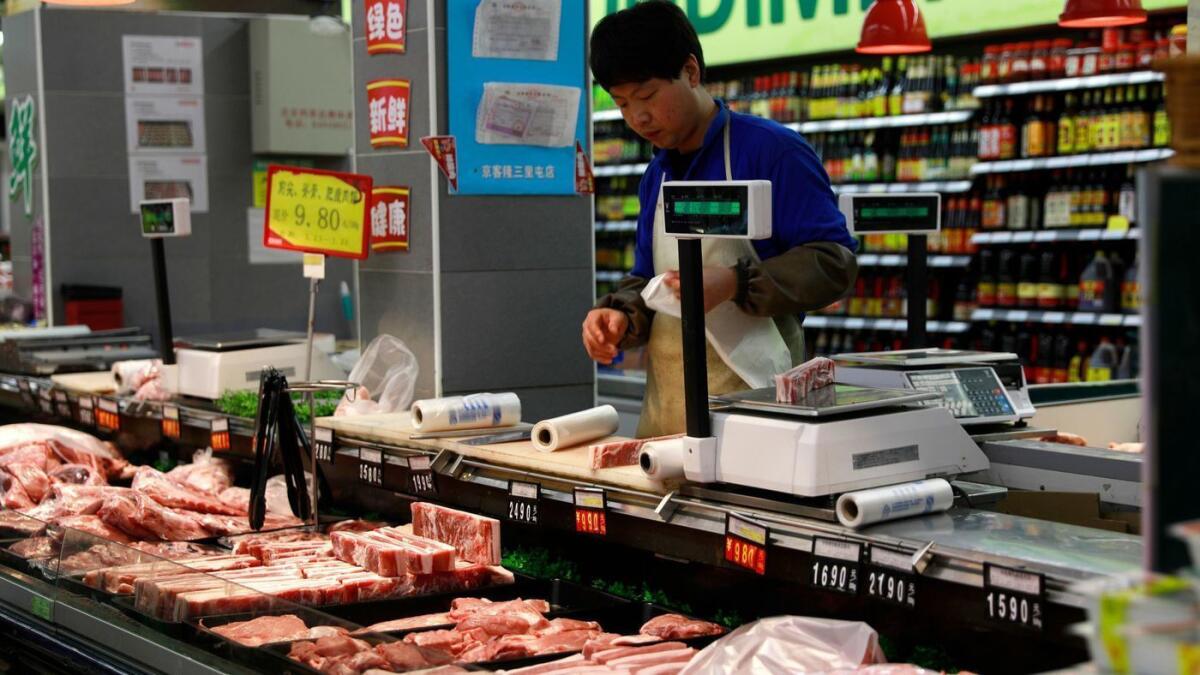Trump administration ramps up trade war with China by releasing list of new tariffs

Reporting from Washington — The Trump administration on Tuesday escalated the brewing trade war with China by releasing a long list of imports that could soon be slapped with 25% tariffs.
The move is likely to be met with retaliatory action from China and could further rattle stock markets and raise fears of higher consumer prices in China and the U.S.
The proposed new tariffs amount to $12.5 billion on about $50 billion in goods. They would affect hundreds of China-made products such as semiconductors, car and aircraft parts and machine tools.
Even so, some economists see the tit-for-tat actions and increasing rhetoric on both sides as brinkmanship leading to possible direct talks that could still prevent a trade conflict from spinning out of control.
Trump’s latest tariffs would take effect in June at the earliest and are meant to punish China for intellectual property theft. They would follow Trump’s move last month to impose stiff tariffs on steel and aluminum from China and some other nations, and an earlier action to levy penalties on Chinese solar panels.
China responded Monday to the steel tariffs with its own duties on $3 billion of U.S. pork, dried fruit and steel pipes. And anticipating the upcoming batch of new tariffs, China’s ambassador to Washington, Cui Tiankai, said that Beijing is prepared to meet them eye for eye.
“We will certainly take countermeasures, of the same proportion, and the same scale, same intensity,” Cui said in remarks broadcast on Chinese state television Tuesday.
But even as both sides ramp up the pressure, there are signs that talks between the two economic rivals are continuing and that some concessions from China may be enough to launch formal negotiations and forestall a trade war.
“I would say the pattern being established is that if trade partners make small concessions that the administration can trumpet, that seems to be sufficient,” said David Dollar, a senior fellow in the John L. Thornton China Center at the Brookings Institution.
But he added: “I’m certain China will retaliate in some way, as they always have. The risk is, if the administration rolls out more measures and people’s egos get involved, and it ratchets up from there, then it starts to become significant for the U.S. economy.”
Trump on Tuesday again suggested that his tariffs are meant to pressure Beijing to come to the table and make concessions.
“We’ll be working with China, we’ll be negotiating with China,” Trump said, repeating his “great respect” for Chinese President Xi Jinping.
“We intend to get along with China, but we have to do something very substantial” on trade, Trump said.
In the past the president also has said that he would be willing to cut China some slack on trade if Xi helped put more economic pressure on North Korea to rein in its nuclear program. In May, Trump is planning to meet with North Korean leader Kim Jong Un in an unprecedented summit.
“I think Xi is in a stronger position,” said Nicholas Lardy, a China expert at the Peterson Institute for International Economics, referring to Xi’s recent meeting with Kim in Beijing and the implications from their restored relations. The Chinese president “now has a working relationship with Kim,” Lardy said, “and implicitly the threat must be, ‘If you put all those tariffs on us, we’re not going to cooperate with shutting down North Korea economically.’”
What’s more, skeptics note that Trump has backed down from his fiery rhetoric before. He declined to label China a currency manipulator as he had promised he would during the campaign.
More recently, after vowing to slap across-the-board steel tariffs on all U.S. importers, he exempted most of the largest players. And he accepted a surprisingly modest rewrite of the U.S.-South Korea trade deal, after long bashing that agreement as “horrible.”
China’s Cui argued Tuesday that China is already responding to U.S. concerns, strengthening protection and enforcement of U.S. intellectual property. “We are making progress,” he said.
But in a 215-page report, the Trump administration detailed China’s long practice of pressuring U.S. firms to turn over technology and trade secrets, and in some cases stealing intellectual property by using cybertheft and other forms of industrial espionage.
That finding, under Section 301 of a 1974 U.S. trade law, gives the president wide discretion to impose tariffs and take other actions to remedy the problem. Separately, Trump’s Treasury Department is readying rules that would restrict Chinese investments in the U.S.
Now that the list has been released, it is likely to trigger an onslaught of additional lobbying from corporate interests. Already some of the nation’s largest firms such as General Electric, as well as farming and industry groups, were urging the White House not to escalate, worried that the actions will ultimately hurt American firms’ global supply chains and their sales in China.
The Section 301 tariffs would not take effect immediately. There would be a one-month period of public comments, and a hearing has been scheduled for May 15, before a final list is adopted. The tariffs would have to be implemented by mid-August under Section 301.
In releasing the list of some 1,300 items, U.S. Trade Representative Robert Lighthizer said the total value of imports subject to the tariffs “is commensurate with an economic analysis of the harm caused by China’s unreasonable technology transfer policies to the U.S. economy.”
Lighthizer said previously that the items were being selected on the basis of what would have the biggest effect on China and the smallest hit on U.S. consumers.
The Section 301 tariffs include many products such as aerospace parts and machine tools that are imported by California businesses. And add to that Monday’s announced Chinese retaliatory tariffs on California agricultural products, and the overall effect of the trade conflict could be particularly painful for the state.
China buys billions of dollars of soybeans from the United States, but Chinese imports of the American product — important for a swath of states in the Midwest — have slowed so far this year amid rising trade tensions with the U.S. After Trump imposed tariffs on imports of solar panels, Beijing responded by initiating an investigation into U.S. sorghum imports.
And the steel and aluminum tariffs by the U.S. were met with 15% tariffs on 120 U.S. imports to China, such as fresh fruits, nuts and wine, and 25% tariffs on eight products worth about $2 billion, including U.S. pork and recycled aluminum.
“This is just signaling intention rather than upsetting the global economic apple cart,” said Claire Reade, senior counsel at Arnold & Porter and an assistant U.S. trade representative for China affairs in the Obama administration. “So the real question is: What happens next?” she said of the impending Section 301 tariffs.
For domestic political considerations and bargaining leverage, she said, “it’s going to be critical for China to appear strong, [and] because of that, China is not going to turn the other cheek. It is not going to take this lying down.”
John Frisbie, president of the U.S.-China Business Council, a group representing 200 large American companies doing business in China, said, “China needs to substantially improve market access and competitive conditions for American companies selling to and investing in China in certain sectors, but unilateral tariffs may do more harm than good and do little to address the problems in China’s IP and tech transfer policies.”
Jay Timmons, president of the National Assn. of Manufacturers, said the tariffs are “likely to create new challenges in the form of significant added costs for manufacturers and American consumers.”
U.S. stocks, which had been rising in after-market trading, sunk into negative territory after the list was released Tuesday evening.
Even if Trump follows through and implements new Section 301 tariffs and Beijing responds in like manner, the overall figures involved would still amount to a fraction of the $630 billion in trade between the two countries. China’s total exports to the U.S. account for only about 3% of that country’s economy.
“I don’t know that we have enough leverage,” Reade said. “China does not need the U.S. market badly enough to turn into a market economy.”
Even so, Reade and other trade and economic experts can only speculate how far Trump will go to force China to change its state-controlled and aggressive economic policies. Businesses and markets are nervous in part because Trump has not let up in railing against Chinese economic behavior and the large U.S. trade deficit.
Also, a recent reshuffling of his Cabinet has shifted the balance in the White House to a more hard-line posture. His top trade and economic officials such as Lighthizer and trade advisor Peter Navarro have similarly visceral reactions to China’s mercantilism as the president, viewing the Asian giant nation as an economic adversary and serious threat to America’s long-run prosperity and national security.
Wendy Cutler, who has led trade negotiations for Presidents George W. Bush and Barack Obama and is vice president at think tank Asia Society, thinks that Trump could be placated if Beijing offered a deficit-reducing package and structural reforms — with a timeline, milestones and some down payment.
For now, there’s at least a two-month window before the new tariffs take effect, she said, and the two sides appear to be continuing to talk.
“Communication is going on, and that’s encouraging. Markers are being put down,” she said. “Is there enough on the table that could result in negotiations? It’s too early to tell.”
Follow me at @dleelatimes
UPDATES:
3:35 p.m.: This article was updated with comments from Lighthizer and additional reaction from industry groups and analysts.
This article was originally published at 2:45 p.m.
More to Read
Inside the business of entertainment
The Wide Shot brings you news, analysis and insights on everything from streaming wars to production — and what it all means for the future.
You may occasionally receive promotional content from the Los Angeles Times.











